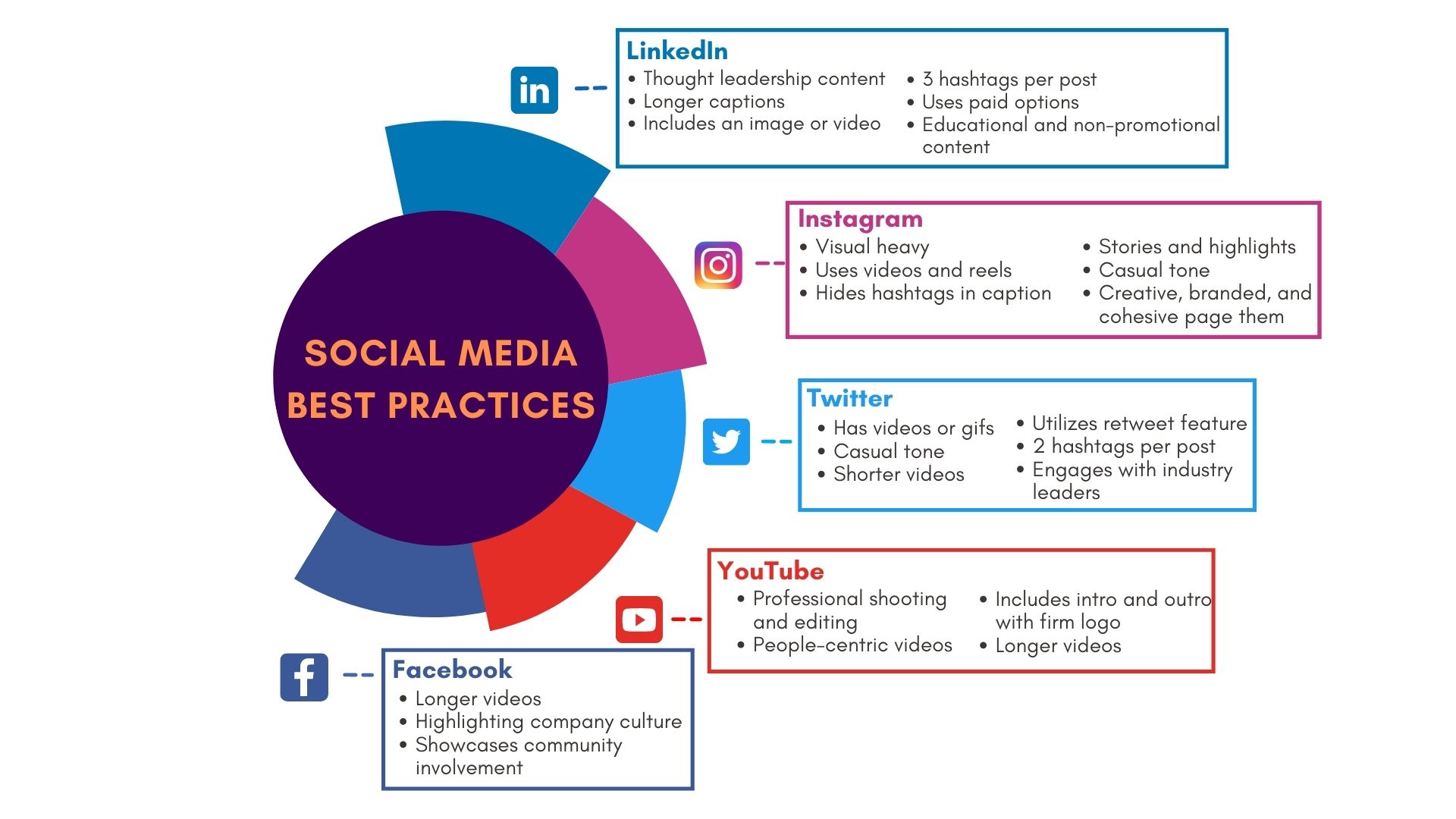
Law Firm Social Media Strategy: The Ultimate Checklist
Having a social media presence has become an essential part of doing business in the modern world. A law practice that isn’t interacting with the public on at least one or two social media platforms is as good as invisible. That said, some law firms still struggle to implement effective social media marketing strategies that really drive engagement and quality leads. This is a huge missed opportunity as an effective social media presence can help lawyers attract prospective clients and build valuable connections. In fact, over 90% of marketers use social media. So, if your law firm isn’t leveraging social media to its fullest potential, it may be hard to remain competitive.
The Necessity of Social Media for Modern Law Practices
With so many different platforms available, and each having its own specific characteristics and quirks, it can be difficult to know where to start and on which platform to focus your efforts. To make sure your firm gets going in the right direction, we’ve put together a social media strategy checklist for law firms. If you’re just starting out, this checklist will help you put together a reliable social media strategy. If you’ve already started building a presence, it will show you
Social Media for Law Firms: The Ultimate Lawyer Social Media Checklist
1. Create a Seamless Brand Experience
Today’s social media users are much savvier than they once were, and are expecting a seamless, cohesive feel on brands’ pages. First, you must ensure all your social media pages are optimized with a profile picture and header (if applicable) that uses your firm’s logo, colors, and brand fonts. Then, you should also focus on filling your bio or about section to its fullest potential. Make sure it is very clear to users what your law firm does and what your values and goals are. Also, ensure your page contains clear contact information, such as your website, a link to a contact form, your address, a help email, etc.
2. Define Your Target Audience
The single most important part of planning your strategy is to know your target audience. Everything you do, including the blog posts you write, is going to be geared towards nurturing and growing your target audience. The more clearly you define your audience, the better you can understand how and where to reach your best prospects.
You should be as detailed as possible when considering who you are trying to reach. Think about age, gender, profession, marital status, etc. No detail is too small to be considered. Go beyond generalizations. Your target audience should not be as broad as “people who need a lawyer.” Rather, you want to define your target audience more specifically and design marketing collateral that speaks directly to them, and therefore engages them. For example, if your firm is looking to expand its personal injury niche, you might define your target audience as follows: “people in the New York City area who have recently been involved in a traffic accident and might be looking for a personal injury or criminal defense lawyer”.
3. Select Your Platform(s)
Once you’ve defined your target audience, you’ll want to do some research on where your audience is most active and likely to engage with your law firm page. You should be able to pick out the social media platforms they are most likely to use. For example, if your audience is made up of professionals, they’re likely on LinkedIn and Twitter. If you’re looking for millennials or retired seniors, you’d probably do better with Facebook and YouTube, and if you’re trying to reach a young audience, you’ll do well to use Instagram or even experiment with newer apps like TikTok.
Most social media channels will give you a breakdown of their target audience demographics so take a look through this and also keep an eye on industry reports and surveys that can reveal valuable information to help guide your decision. It’s also a good idea to check out where your competitors are active.
While it’s useful for brand awareness to have a presence on every app, make sure you focus the bulk of your energy on the platforms that’ll lead to a greater ROI.
Related: How Lawyers Can Use Social Media to Build Their Brand & Grow Their Practice [Webinar]
4. Research Platform Best Practices
While there are some solid best practices that are true across all platforms, there are conventions that are specific to each platform that should be noted. For example, Instagram is a visual-heavy platform moving more towards video, whereas LinkedIn necessitates longer captions. So, if you posted a video to LinkedIn in the Reel format with a one sentence caption, it probably wouldn’t do as well as it would on Instagram.
Keep in mind that not all content is suitable for every social media platform. In this blog post, we dive into the general guidelines for posting on each social media platform, so you can see consistent growth with your social following.
5. Create and Curate Content That Speaks to Your Audience
With a clearly defined audience and realistic goals in mind, the next step is to create and share content that aligns with your goals and provides real value. It should be educational or help audience members solve a problem. You could, for example, post content on legal terms and examples, or news involving trials or changes in the law.
Always try to frame your own written content around your audience’s challenges. A general rule of thumb is that the content you share should be about 30% promotional and about 70% educational. The idea is to show that you are knowledgeable and up-to-date in your areas of practice without making your account look like an endless, self-promotional commercial. Try framing your posts through the lens of thought leadership, so if you’re sharing your latest blog post, don’t simply state ‘Here’s our latest blog’, create a caption and visuals that focus on promoting the educational component of your content that answers people’s pressing questions.
6. Define Clear, and Realistic Measurement and ROI Goals
As you’re planning your law firm’s social media strategy, it’s imperative that you identify what your goals are with social media and develop clear metrics to track them. If you’re not getting page views, and shares and visitors aren’t engaging with your content, you’re not generating any return on investment (ROI).
Some of the goals you may have for social media marketing include brand awareness, traffic to your website, generating new leads for newsletters, and acquiring new clients. Beyond likes and followers, you want to understand how many people interact with your content. You can learn more about engagement by tracking retweets, shares, comments, views, and sessions to your website from each channel. We recommend tracking these with a tool like HubSpot or even with in-platform analytics features.
7. Streamline Your Efforts with Social Media Tools
To help save time, look to utilize some of the various social media tools and apps that will streamline your efforts. Some of our favorites are HubSpot for planning and scheduling posts in advance. We also recommend using hashtagify.me for hashtag intelligence and Canva to create beautiful imagery or short video clips.
Everyone will have a preference for different tools, so be sure to try a few and go with the ones that make the most sense to you.
8. Create Policies on How to Respond to Your Audience
Make sure to set some brand guidelines on things like voice, writing style, color themes, font style, and anything else that contributes to your firm’s appearance online. It’s important when making content, that there is a seamless and unified feel across all posts.
Also, make note of how responses via social media should go. If more than one person will be interacting with your audience, it’s important to make sure everyone involved knows what’s expected of them. Responses should appear unified and consistent. The personality presented should be that of your law firm, not the individuals doing the posting.
It is especially important that everyone involved knows how to deal with negative comments. Responding improperly to negative comments can do great harm to your law firm’s reputation.
9. Create an Employee Advocacy Strategy
Content should not be merely posted to your firm’s Company Page. Make the effort to invest time and money to properly train your lawyers and employees on the use of social media and empower them to regularly share relevant and approved content to their own audiences. This will increase your reach and exposure on social media, making it easier to connect with those who may not yet follow your Company Page. We suggest investing in employee advocacy tools such as SocialHP, LinkedIn Elevate, PostBeyond, or Clearview Social that make it easier for everyone at your firm to participate in social media. These tools can send out prompts to employees to share appropriate content, and artificial intelligence can also dictate when content should be shared, making it even more impactful.
10. Measure and Optimize Your Strategy Through Data Analytics
A social media strategy is not complete without capitalizing on analytics. Since you’ve been tracking your social media performance, now is the time to reflect on the data on both a weekly and monthly basis to figure out what worked and what didn’t. Take special note of any changes, either positive or negative, in the data you’ve been collecting to draw conclusions on what worked and what didn’t.
Sometimes even taking a look at particular posts that performed really well or really poorly can be helpful in assessing what was most effective. For example, if you see a post got above-average engagement, ask yourself what made it unique. What time did you post? How long was the caption? What visuals did you use- image, video, how did you create it? What subject was the post about? Capitalizing on data analytics is more than just keeping track of numbers. You must think critically about the movement of numbers and use this to draw conclusions and improve your strategy.
Takeaway:
Following the steps above as you plan and revise your law firm’s social media strategy will help you to achieve the best ROI possible. Sticking to this social media strategy checklist for law firms will ensure that you remain focused on your goals and whether or not you are reaching them.
Want more tips on how to take your firm’s social media to the next level? Check out this free eBook: Advanced Social Media Strategies for Law Firms.
Do you need help driving real business results through social media? Our social media offerings can be customized to your law firm’s needs and realities. In addition to social media management, we offer social media consulting and training for our clients. Contact us today for a free consultation.
This post has been edited and republished from Oct. 12, 2021.
Are you ready to get started generating new, qualified leads?
Contact us to get started and let us help you energize your digital marketing and business development efforts.
Contact Us



